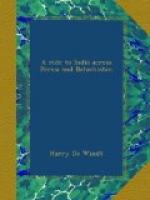[Footnote B: These rings are sometimes so heavy that they are attached to a band at the top of the head to lessen the weight on the nostril.]
[Footnote C: A town in Western Baluchistan.]
[Footnote D: The word “Mekran” is said to be derived from “Mahi-Kharan,” or “Fish-eaters,” which food the inhabitants of this maritime province subsisted on in Alexander’s time, and do still.]
[Footnote E: Russian, “Fool.”]
CHAPTER X.
BALUCHISTAN—GWARJAK.
Most European travellers through this desolate land have testified to the fact that the most commendable trait in the Baluch is his practice of hospitality, or “zang,” as it is called. As among the Arabs, a guest is held sacred, save by some of the wilder tribes on the Afghan frontier, who, though they respect a stranger actually under their roof, will rob and murder him without scruple as soon as he has departed. The natives of Kanero and Dhaira (the two villages lying between Noundra and Gwarjak) were, though civil, evidently not best pleased at our appearance, but the sight of a well-armed escort prevented any open demonstration of ill feeling.
The first day’s work after Noundra was rough, so much so that the camels could scarcely struggle through the deep sand, or surmount the steep, pathless ridges of slippery rock that barred our progress every two or three miles. Though the greater part of the journey lay through deep, drifting sand, the soil in places was hard and stony, and here the babul tree and feesh palm grew freely, also a pretty star-shaped yellow flower, called by Baluchis the “jour.” This plant is poisonous to camels, but, strangely enough, harmless to sheep, goats, and other animals.
For a desert-journey, we had little to complain of as regards actual discomfort. There were no mosquitoes or sandflies, and the heat, though severe, was never excessive save for a couple of hours or so at midday, when enforced imprisonment in a thin canvas tent became rather trying. There was absolutely no shade—not a tree of any kind visible from the day we left Beila till our arrival at Dhaira about midday on the 31st of March. Scarcity of water was our greatest difficulty. At Noundra it had been salt and brackish; at Kanero we searched in vain for a well. Had we known that a couple of days’ march distant lay a land “with milk and honey blest,” this would have inconvenienced us but little. The fact, however, that only three barrels of the precious liquid remained caused me some anxiety, especially as the first well upon which we could rely was at Gwarjak, nearly sixty miles distant.




